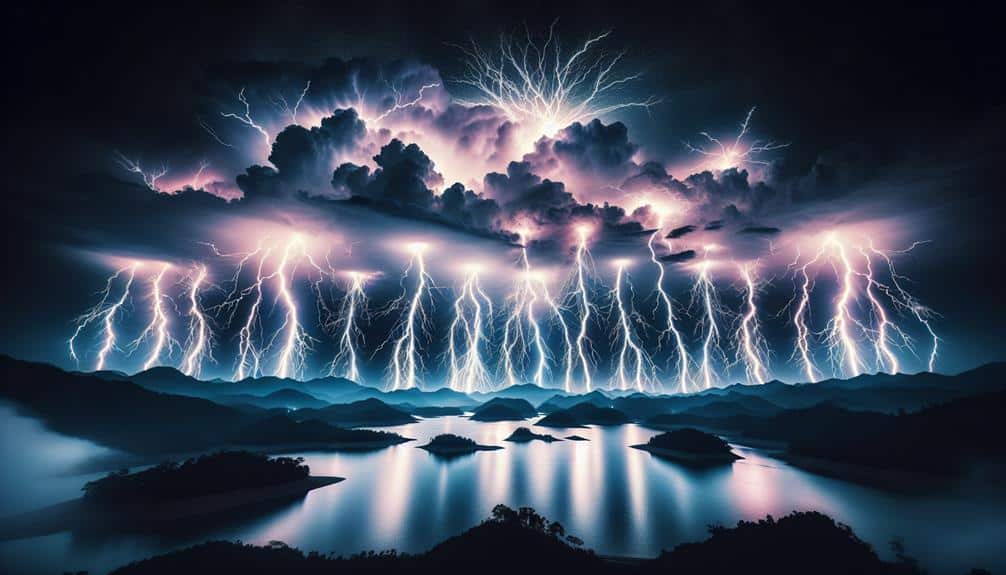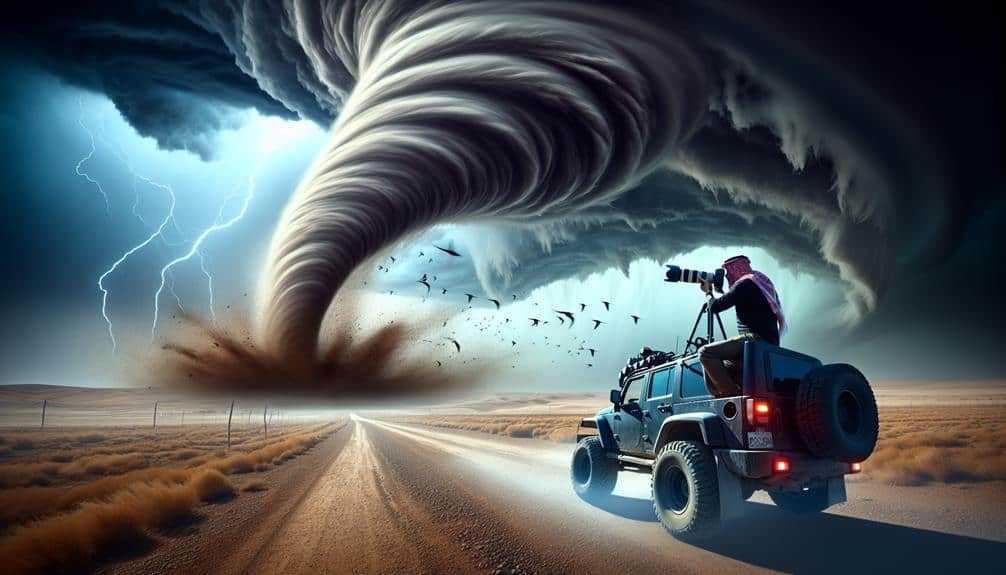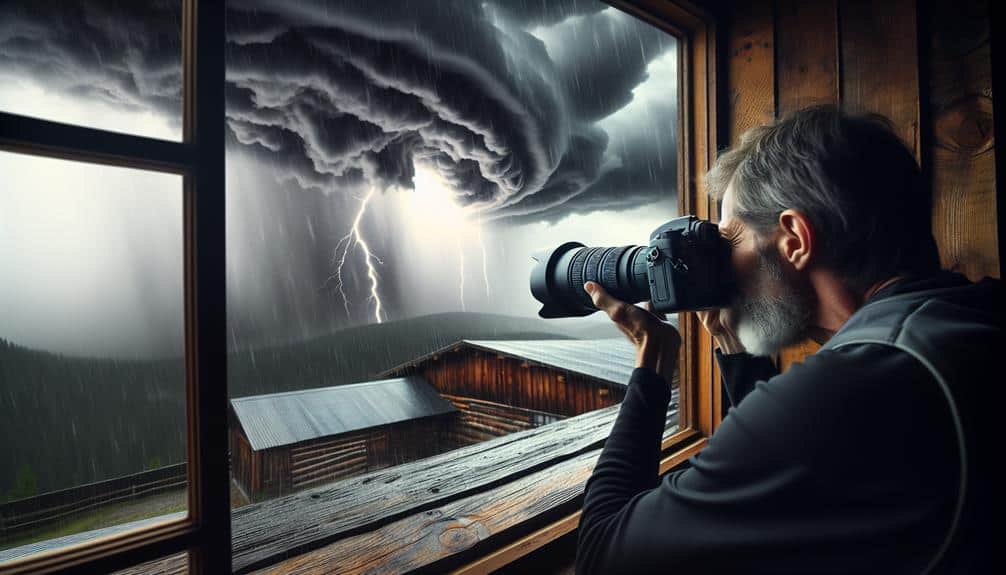We need the right gear to master storm surge photography, starting with a weather-sealed wide-angle lens for capturing the scene's full scope. We should time our shots for dynamic moments during the storm's approach or the serene calm afterward, optimizing lighting during golden or blue hours. Compositionally, applying the rule of thirds and using leading lines can infuse energy into our photos. Safety is essential—gear like waterproof boots and high-visibility jackets, alongside notifying someone of our plans, keeps us prepared. Post-processing involves adjusting exposure, contrast, and fine-tuning details for that polished, dramatic final image. Explore further to enhance your technique.
Key Points
- Select weather-sealed, wide-angle prime lenses for sharp, reliable, and broad scene capture.
- Conduct risk assessments and inform someone of your plans for safety.
- Capture storm surges during dynamic moments using weather tracking tools.
- Use the rule of thirds and leading lines to create compelling compositions.
Choosing the Right Gear
When it comes to capturing extreme weather, we must always prioritize selecting gear that can withstand harsh conditions and deliver high-quality images. First, let's talk lens options. A wide-angle lens is essential for storm surge photography, allowing us to capture the breadth and intensity of the scene. We should look for lenses with weather-sealed construction to prevent moisture and debris from damaging our equipment. Prime lenses, known for their sharpness and reliability, are also a reliable choice in these challenging environments.
Next, focusing on camera settings is vital. We'll need a fast shutter speed to freeze the motion of crashing waves and driving rain. Typically, setting it above 1/1000th of a second ensures we capture sharp images without blur. Adjusting the ISO is necessary to maintain image clarity in fluctuating light conditions; an ISO range between 100 and 800 is generally ideal.
For aperture settings, a mid-range f-stop, such as f/8 or f/11, provides a good depth of field, ensuring both the foreground and background are in focus. Manual mode gives us the freedom to experiment and adapt quickly to changing conditions, guaranteeing we get the perfect shot every time.
Safety Precautions
Ensuring our safety while photographing storm surges requires meticulous planning and adherence to several key precautions. First, we must conduct a thorough risk assessment. This involves analyzing weather forecasts, tidal patterns, and historical data to understand the potential severity of the storm surge. We should avoid areas known for rapid water level changes or unstable ground.
Next, let's establish our emergency protocols. Carrying a fully charged satellite phone ensures we can call for help even in remote locations. We need to inform someone reliable of our exact plans and expected return time. Having a pre-determined safe zone—preferably on higher ground—is essential in case conditions worsen unexpectedly.
We also need the right protective gear. Waterproof boots, gloves, and a high-visibility jacket are non-negotiable. Let's not forget a first-aid kit, complete with essentials like bandages, antiseptics, and any personal medications.
Lastly, we must remain situationally aware. Continually scanning the environment for changes in water levels, wave patterns, and wind direction helps us react swiftly to evolving dangers.
Best Timing Tips
Having secured our safety with thorough measures, we can now focus on the best timing to capture the most dramatic storm surge images. Timing is everything in extreme weather photography, and mastering it requires a combination of location scouting and meticulous weather tracking.
Here are some essential tips to achieve that perfect shot:
- Pre-Storm Setup: Head out as the storm is approaching. This guarantees you capture the initial impact, providing dynamic and intense scenes.
- Golden and Blue Hours: Utilize the golden hour (shortly after sunrise or before sunset) and the blue hour (twilight). These periods offer the best natural lighting conditions, enhancing the drama and texture in your images.
- Peak Surge: Timing your shots for when the storm surge is at its highest can yield the most breathtaking photos. Use weather tracking tools to predict these peak moments accurately.
- Post-Storm Calm: Don't rush to pack up once the storm passes. The post-storm calm can offer unique lighting conditions and a surreal atmosphere, great for capturing the aftermath.
Adjusting your camera settings to match the changing lighting conditions is essential. Employ a fast shutter speed to freeze the ferocity of the waves, and consider using a tripod for stability.
Composition Strategies
Crafting compelling compositions in storm surge photography demands a keen eye for balance, leading lines, and focal points that highlight the raw power and beauty of extreme weather. We must start by identifying the main subject—often the turbulent waves or an ominous sky—and position it using the rule of thirds to create a dynamic and engaging image.
Lighting techniques play an essential role in enhancing the drama of the scene. We should aim to shoot during the golden hours—early morning or late afternoon—when natural light casts long shadows and adds depth to the composition. If we're dealing with darker stormy conditions, utilizing off-camera flash can help illuminate key elements without overpowering the natural ambiance.
Framing techniques are equally significant. Elements like tree branches, coastal rocks, or even debris can be used to frame the storm surge, drawing viewers' eyes directly to the action. Leading lines—such as the shoreline or crashing waves—guide the viewer's gaze through the photo, adding a sense of movement and energy.
Post-Processing Essentials

Post-processing is an essential step in storm surge photography, allowing us to fine-tune exposure, enhance colors, and bring out the intricate details that might be lost in the raw image. By leveraging Lightroom adjustments and Photoshop techniques, we can transform our captures into compelling, vivid representations of nature's raw power.
In Lightroom, start by adjusting the basic settings:
- Exposure and Contrast: Correct any exposure issues and add contrast to make the image pop.
- White Balance: Adjust the temperature and tint to guarantee the colors are accurate and evoke the mood we desire.
- Clarity and Texture: Enhance the midtones and fine details, making the storm surge appear more dynamic.
- Noise Reduction: Decrease any noise, especially in low-light conditions, to achieve a cleaner image.
Next, we move to Photoshop for advanced techniques:
- Layer Masks: Use them to selectively edit parts of the image without affecting the whole.
- Dodge and Burn: Lighten or darken specific areas to emphasize key elements, like crashing waves or dramatic skies.
- Sharpening: Apply precise sharpening to bring out details in the water and clouds.
- Color Grading: Fine-tune the hues and saturation to create a cohesive, impactful look.
These steps empower us to craft visually stunning images that capture the essence of storm surge photography.
Frequently Asked Questions
How Can I Predict Storm Surge Locations for the Best Shots?
We can predict storm surge locations by analyzing weather patterns, tide levels, and geographic features. By understanding these elements, we'll find the ideal photography angles to capture the most dramatic storm surge shots.
What Are Some Common Mistakes in Storm Surge Photography?
Common mistakes in storm surge photography include neglecting composition tips and ignoring lighting techniques. We often forget to balance the scene or adjust for changing light, which compromises the freedom to capture stunning, dynamic shots.
How Do I Protect My Camera From Saltwater Damage?
To protect our cameras from saltwater damage, we use waterproof equipment and a sturdy protective casing. Additionally, we regularly check seals, use desiccant packs, and rinse off salt deposits with fresh water after each shoot.
Are There Specific Apps for Tracking Storm Surges?
We use storm surge apps to improve our photography planning. These apps provide accuracy in tracking weather patterns and timing, but let's remember their limitations. Combining multiple sources guarantees we capture the perfect shot with minimal risk.
What Legal Permissions Are Needed for Photographing Storm Surges?
Imagine the crashing waves as we capture the fury of the storm. We need to check permit requirements and photography restrictions. Local authorities might require permissions, especially in protected areas. Let's make sure we're compliant and free to shoot.


